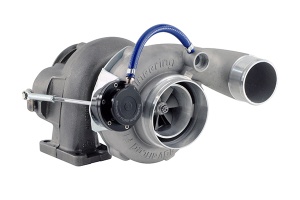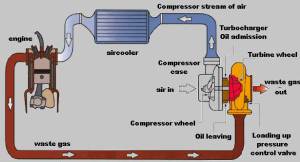For many people, a turbocharger is a magical device that makes cool noises, and their car go faster. As Jeremy Clarkson of Top Gear once said, “Exhaust gasses go into the turbocharger and spin it, witchcraft happens and you go faster.” As funny as this explanation is, he isn’t too far off, aside from the witchcraft part.
 The blowing air spins the wheel
The blowing air spins the wheel
A turbocharger is comprised of two parts, commonly known as the cold side and hot side. The “cold side” is the part of the turbocharger that compresses the air. The “hot side” is the part that the exhaust gasses pass through, hence the reason for calling it the “hot side”. As the exhaust gasses pass through the “hot side” they spin something called a turbine wheel. If you've ever played with a pin wheel as a child, a turbine acts the same way, the blowing air spins the wheel. The turbine wheel is connected to a shaft that runs through the turbocharger housing and on the other end is the compressor wheel. The compressor wheel is what sucks in the outside air and compresses it.
This phenomenon is known as "turbo lag"
In a perfect world, the compressor wheel would be able to compress the air while moving at a slow speed; however, this is not the case. Typically for a small factory installed turbocharger, the compressor wheel doesn’t start to compress the air until around three thousand engine RPM. This phenomenon is known as “turbo lag”. The larger the turbocharger is, the longer this “turbo lag” lasts. Once the air starts getting compressed, this is when you feel the engine make more power due to the denser, compressed air that is being forced into the cylinder. Denser air allows for more fuel to be added, and therefore more power is made during combustion. Even though the engine is at around three thousand RPM when the air starts being compressed, the compressor and turbine wheel can spin at speeds up to or above ten thousand RPM! After the air is compressed, it increases in temperature due to the air molecules ramming into each other as they are squished together. This is why most modern turbocharged engines today have an intercooler for the compressed air to pass through before it reaches the engine. An intercooler is essentially the same as the radiator on the front of your car, except instead of coolant flowing through it, you have compressed air. The outside air flows through the intercooler and cools down the hotter, compressed air inside.
Aside from the power gains you get from a turbocharger, you also make the engine more efficient by capturing the energy from the exhaust gas coming out of the manifold. In a naturally aspirated engine, exhaust gas simply goes out the end of the tailpipe. The ability to make engines more efficient and more powerful while using a smaller displacement is one of the major reasons that many automakers today are using turbochargers on their engines. Ford is one of the main companies doing this; they advertise it as their Ecoboost line of engines.
About the Author: David Fresne
 David Fresne is a Mechanical Engineering Student at SUNY Polytechnic. He likes to work on his B6 Audi A4 and motorcycle in his free time.
David Fresne is a Mechanical Engineering Student at SUNY Polytechnic. He likes to work on his B6 Audi A4 and motorcycle in his free time.











